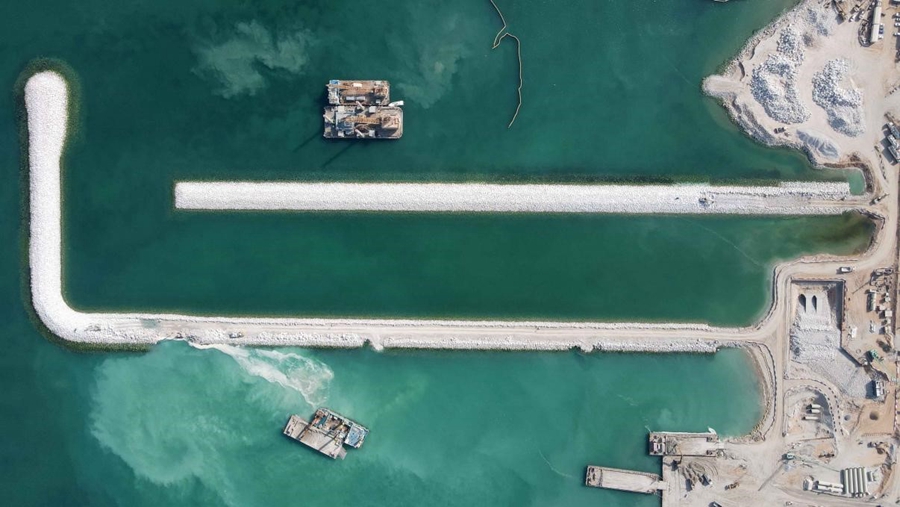Belt and Road cooperation a path of hope for countries (3)
On May 27, Hungary inaugurated the country’s largest solar power plant, the 100-megawatt (MW) photovoltaic power plant project built by China National Machinery Import and Export Corporation (CMC) near the southwestern city of Kaposvar.
The plant, whose construction kicked off in June 2019, is expected to produce 130 million kWh of electricity annually after it is connected to the grid, and help Hungary save 45,000 tons of standard coal and reduce the country’s carbon dioxide emissions by about 120,000 tons each year. It’s believed that the project bears great significance for improving Hungary’s energy structure and clean energy development.
As a key project in the cooperation between China and Hungary under the framework of the Belt and Road Initiative (BRI) and a representative of a great number of BRI projects, the Kaposvar solar power plant has fully demonstrated the philosophy of peaceful cooperation and win-win results upheld by the BRI.
As a result of the active participation and support of various parties, the BRI has become the world’s largest platform for international cooperation and a well-received global public good.
As of January 2021, China had signed 205 cooperation documents on jointly building the Belt and Road with 140 countries and 31 international organizations.
From 2013 to 2020, the volume of trade in goods between China and countries along the routes of the BRI totaled $9.2 trillion. In the meantime, China has invested $136 billion in countries along the BRI routes and attracted nearly $60 billion of investment from these countries.
In spite of the severe challenges posed by the COVID-19 pandemic, economic and trade cooperation between China and countries along the Belt and Road has shown strong resilience and vitality.
In the face of the current complex international situation and mounting global challenges, countries around the world can only achieve peaceful development and common prosperity by strengthening cooperation and overcoming challenges hand in hand.
By promoting cooperation under the framework of the BRI, China hopes to pursue development, uphold the idea of win-win results, and spread hope together with other countries.
The Chinese-built Addis Ababa-Djibouti railway connecting the two East African countries of Ethiopia and Djibouti is the first cross-border electrified railroad in Africa, and hailed as the lifeline of transportation in Ethiopia.
Since the outbreak of the COVID-19 pandemic, the Addis Ababa-Djibouti railway has played a vital role in guaranteeing people’s livelihood. Thanks to the railway, more than 1.5 million tons of cargos including daily necessities, anti-epidemic supplies, and industrial raw materials have been transported from the Port of Djibouti to the hinterland of Ethiopia. Last year, while improving the efficiency in the transfer of important goods and materials in the East African region, the railway saw its annual volume of freight climb 35 percent year on year.
Ethiopia has planned to build 13 industrial parks along the Addis Ababa-Djibouti railway, among which ten have been completed, creating more than 100,000 jobs and effectively driving economic development for areas near the railway.
If a country participates in the BRI, it can see hope and harvest tangible benefits, said Melaku Mulualem from Ethiopian International Institute for Peace and Development.
With the help of China, the East African region has become a role model of connectivity and rapid development on the African continent. The connectivity will also benefit the construction of the African Continental Free Trade Area (AfCFTA).
In pursuing Belt and Road cooperation, China focuses on the fundamental issue of development, and aims to release the growth potential of participating countries and achieve economic integration and coordinated development to the benefit of all participants.
Such ideas and corresponding efforts have yielded fruitful results. Gwadar, once a small fishing village in Pakistan, is now a modern port. Greece’s Piraeus Port, where even the bridge cranes of the container terminal were too rusty to function normally, has seen its world ranking in terms of container throughput rise constantly. While continuously attracting investment, the China-Egypt TEDA Suez Economic and Trade Cooperation Zone in Egypt serves as a good example of resuming work and production and boosting employment amid the COVID-19.
Belt and Road cooperation binds countries together for the long haul, and forms ties that are extremely difficult to cut, which is perhaps what Chinese President Xi Jinping means when he speaks of the “Community of the Same Destiny,” said an article published on the website of U.S. magazine Forbes.
As countries around the world are eagerly longing for green recovery and a path to sustainable development, China launched a number of green action initiatives covering wide-ranging efforts in green infrastructure, green energy, green transport and green finance, which have received active responses from people of various countries.
As a participant, contributor and trailblazer in global ecological conservation, China is committed to taking concrete actions and making unremitting efforts to foster a community of life for man and nature.
 |  |
Photos
Related Stories
- Xi highlights vital role of BRI solidarity
- Ancient port charts new course towards green, smart hub serving Belt and Road
- BRI opens new ways of trade and investment from China: Turkish businessman
- U.S. should not decry China for lending to BRI countries: media
- China releases Analects of Confucius versions for Belt and Road countries
- Multi-billion-USD investments inked at Silk Road int'l expo
- China's patent grants, applications grow in B&R countries
- China vows belt of cooperation, development with Central Asia
- Int'l community casts vote of confidence in Belt and Road
- Chinese FM puts forward proposals for high-quality Belt and Road development
Copyright © 2021 People's Daily Online. All Rights Reserved.











